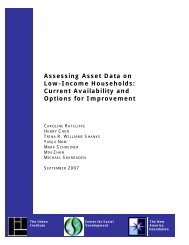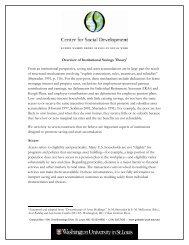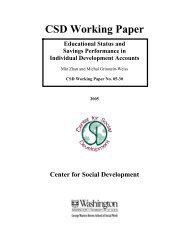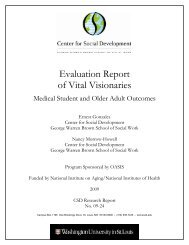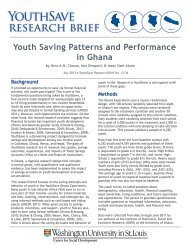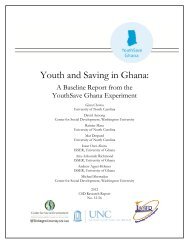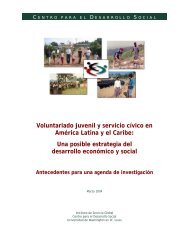Exploring and Assessing Intercultural Competence - Center for ...
Exploring and Assessing Intercultural Competence - Center for ...
Exploring and Assessing Intercultural Competence - Center for ...
Create successful ePaper yourself
Turn your PDF publications into a flip-book with our unique Google optimized e-Paper software.
<strong>Exploring</strong> <strong>and</strong> <strong>Assessing</strong> <strong>Intercultural</strong> <strong>Competence</strong><br />
Table 9: Contrastive Alumni IC Competency at Beginning <strong>and</strong> End of Service<br />
Component |T| Std. Error<br />
Knowledge 12.518* 1.92<br />
Attitude 5.155* 3.96<br />
Skill 6.034* 2.97<br />
Awareness 6.369* 5.26<br />
<strong>Intercultural</strong> Competency (ICC) 7.750* 3.09<br />
Source: Alumni Survey 2006<br />
* significant at p < 0.05<br />
When a dependent variable is measured repeatedly at different time points (e.g., be<strong>for</strong>e <strong>and</strong> after<br />
treatment) <strong>for</strong> all sample members across a set of conditions, the design is called “within-groups”<br />
or “repeated measures ANOVA.” The purpose of repeated measures design is to test the same<br />
group of subjects at each category of the independent variable (cf. Levin, Irwin P. 1999). This, of<br />
course applied in the present study. Thus, one-way ANOVA is generally regarded as an extension<br />
of t-test. This study only reports the eta squares values in order to document the variation in ICC<br />
<strong>and</strong> its dimensions associated with exposure to a new culture (see Table 10 below).<br />
Table 10: Measuring Effect Size of <strong>Intercultural</strong> Competency <strong>and</strong> Its Components<br />
Dimension Eta<br />
Η<br />
<strong>Center</strong> <strong>for</strong> Social Development<br />
Washington University in St. Louis<br />
Squared<br />
η 2 p<br />
Knowledge 0.862 0.744<br />
Attitude 0.574 0.330<br />
Skill 0.635 0.403<br />
Awareness 0.656 0.430<br />
<strong>Intercultural</strong> Competency (ICC) 0.726 0.527<br />
Source: Alumni Survey 2006<br />
The effects of intercultural exposure at the end of service were further examined by using the<br />
analysis of variance to compute partial etas. Etas (η 2 p) show the percentage of variation explained<br />
in each of the dependent variables due to a treatment factor (independent factor). In this case, η 2 p<br />
shows the effect of having been exposed to a new culture. These effects on each dependent<br />
variable are reflected in the reported eta squared values. The effect of exposure to a new culture<br />
accounts <strong>for</strong> 74.4% variation in the knowledge component. Similarly, 52.7% of the variation in<br />
ICC is associated with intercultural exposure.<br />
Another important assumption of this study is that participation in an intercultural service<br />
experience enhances language proficiency. Table 11 illustrates the levels of Spanish language<br />
competency at the beginning <strong>and</strong> end of service. The majority of alumni reported “no ability”<br />
(46.4) or claimed they “were not functional” in spoken Spanish language (28.6) in the beginning.<br />
At the end of service, however, significant improvement was reported by the majority of<br />
respondents, ranging from “satisfying social <strong>and</strong> work needs” to “have sufficient accuracy,” as<br />
indicated in Table 11 <strong>and</strong> graphically illustrated once again in Figure 3 below.<br />
24





